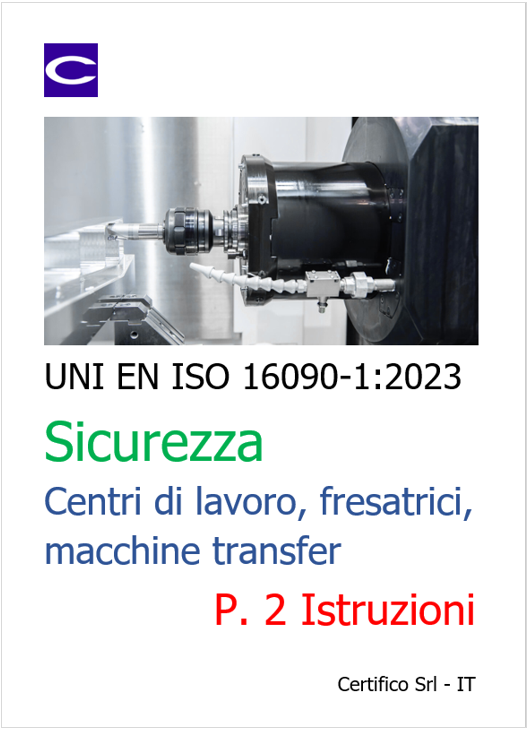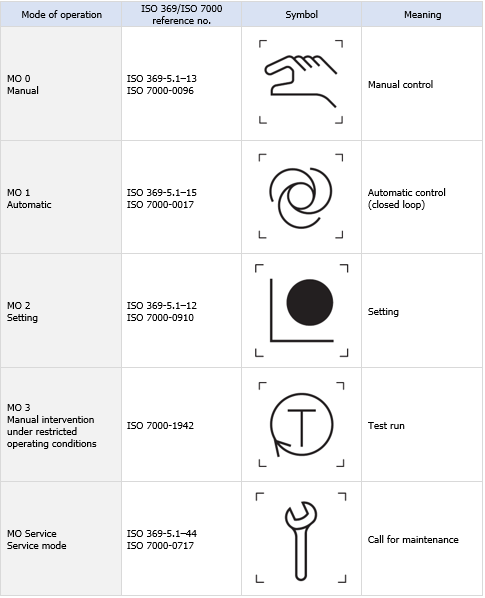
UNI EN ISO 16090-1 Sicurezza Centri di lavoro, fresatrici, macchine transfer / Taglio a freddo metalli - P.2 Istruzioni
ID 17927 | Rev. 1.0 del 20.06.2023 / Documento in allegato
La UNI EN ISO 16090-1:2023 (tipo C ai sensi della EN ISO 12100:2010), specifica i requisiti tecnici di sicurezza e le misure di protezione per la progettazione, la costruzione e la fornitura delle macchine utensili utilizzate per il taglio a freddo di metalli e materiali non combustibili (alesatrici, fresatrici, centri di lavoro, macchine transfer e macchine speciali.
La norma non è armonizzata per la Direttiva macchine 2006/42/CE.
LaUNI EN ISO 16090-1:2023sostituisce la UNI EN ISO 16090-1:2019. Le principali novità della nuova edizione sono:
- introduzione nuove funzioni di sicurezza (Allegato J);
- modifica della MSO (modalità di funzionamento sicuro) in MO (modalità di funzionamento);
- introduzione obbligo uso di un comando di abilitazione nella modalità di funzionamento MO 3;
- aggiunta delle cabine operatore mobili.
Documento d'interesse per i Costruttori (Direttiva macchine 2006/42/CE) e Utilizzatori (D.Lgs. 81/2008).
Doc. 2.Istruzioni per l’uso
Questo secondo Documento esamina quali istruzioni per l’uso debbano essere fornite dal Fabbricante all’Utilizzatore della macchina.
UNI EN ISO 16090-1:2023
Sicurezza delle macchine utensili - Centri di lavoro, fresatrici, macchine transfer - Parte 1: Requisiti di sicurezza
La norma specifica i requisiti tecnici di sicurezza e le misure di protezione per la progettazione, la costruzione e la fornitura (inclusi l'installazione e lo smantellamento, le modalità di trasporto e manutenzione) di fresatrici fisse, incluse le macchine in grado di eseguire operazioni di alesatura, centri di lavoro e macchine transfer progettate per l'uso in produzione continua, che sono destinate a tagliare a freddo metalli e altri materiali non combustibili ad eccezione del legno o materiali con caratteristiche fisiche simili a quelle del legno come definito nella norma UNI EN ISO 19085-1, e vetro, pietra e materiali lapidei agglomerati come definiti nella UNI EN 14618. La norma si applica alle seguenti macchine:
a) alesatrici e fresatrici a comando manuale senza controllo numerico;
b) alesatrici e fresatrici a comando manuale con controllo numerico limitato;
c) centri di lavoro e fresatrici a controllo numerico;
d) macchine transfer e macchine per impieghi speciali;
e) macchine dotate dei seguenti dispositivi/attrezzature, i cui rischi sono stati affrontati:
- magazzino utensili;
- cambiautensili;
- meccanismi di movimentazione dei pezzi;
- meccanismo/i di bloccaggio del/dei pezzo alimentato/i;
- trasportatore/i di trucioli;
- porte ad azionamento elettrico;
- cabina/e operatore mobile/i;
- attrezzature aggiuntive per la tornitura;
- attrezzature aggiuntive per la molatura.
[...]
Estratto parti UNI EN ISO 16090-1:2023specifiche per le istruzioni per l’uso.
6 Information for use
6.1 General
Information for use shall be provided in accordance with ISO 12100:2010, 6.4.
[...]
6.2.2 Symbols of operating modes (MO) on machines
For identification of the mode of operation (MO), the letter code (e.g. MO 0 or manual mode) or the following standardized symbols shall be used on the command devices and if necessary, on the HMI or the mode selection device:

Table 4 - Symbols for displaying modes of operation on machines
[...]
6.3 Instruction for use
6.3.1 General
An instruction handbook in accordance with ISO 12100:2010, 6.4.5, completed with the specific information for the stated machine, shall be provided with the machine.
The instructions for use shall provide all necessary information regarding transport, assembly/disassembly, operation, setting, maintenance, cleaning, etc., to train or qualify the staff sufficiently in intended and safe use of the machine.
The instruction handbook shall specify that it is essential that operators be adequately trained in the safe use, adjustment and operation of the machine. At least the following information shall be given:
a) specifications on machining processes and modes of operation for which the machine is suited. For all modes of operation, detailed descriptions for the intended use of these modes of operation shall be defined:
1) information about reasonably foreseeable misuse;
2) possible residual risks, e.g. through any provided mode of operation;
3) the necessary qualification of operators in MO 1, in particular if the machine provides the mode of operation MO 2, MO 3 which, for example, requires experience in:
i) adjusting and clamping of workpieces and devices;
ii) setting, operating and monitoring of machining centres, milling machines and transfer machines;
iii) selection, use and mounting of tools;
iv) data input for the machining of workpieces and optimization of the machining process;
v) specific hazards and required protective measures;
vi) use of personal protective equipment (PPE)
4) if the machine provides MO Service in accordance with 5.2.4.7, the manufacturer of the machine shall additionally specify:
i) the details of the application(s) of service mode;
ii) the required skills and the skill level for the operator(s) to operate service mode;
iii) the following safety instructions in the instructions for use:
- Before selecting MO Service, a chain or barrier with warning sign shall be set up to prevent unintended access to the machine. The warning sign indicates that service operations are being conducted on the machine and that unauthorized persons are not permitted to pass beyond the point of the chain or barrier;
- instructions for use need to give clear indication about the kind and setup of the chains or barriers to be used;
[...]
6.3.7 Residual risks to be addressed to the machinery user
Information shall be provided stating that guards supplied with the machine minimize the risks of ejection only in combination with all other measures described in the instruction for use.
Advice shall be provided stating that processing substances such as aluminium, titanium or magnesium can cause additional hazards, e.g. fire and explosion or noxious dust.
Information shall be provided to the user for the utilization of appropriate inert gas or dry powder in the extinguishing system if it is foreseeable that machining leads to the existence of combustible dust, e.g. machining of aluminium, titanium or magnesium.
Instructions shall be provided on the necessary checks following the exchange of components, removal of equipment or change of software where these may affect safety functions (see also 6.3.1).
...
segue in allegato
Certifico Srl - IT | Rev. 1.0 2023
©Copia autorizzata Abbonati
Matrice Revisioni:
| Rev. |
Data |
Oggetto |
Autore |
| 1.0 |
20.06.2023 |
Aggiornamento normativo |
Certifico Srl |
| 0.0 |
27.10.2022 |
-- |
Certifico Srl |
Collegati:
Allegati
|
Descrizione |
Lingua |
Dimensioni |
Downloads |
 |
|
EN |
216 kB |
150 |
 |
|
EN |
181 kB |
108 |
Allegati
|
Descrizione |
Lingua |
Dimensioni |
Downloads |
 |
|
EN |
216 kB |
809 |



































